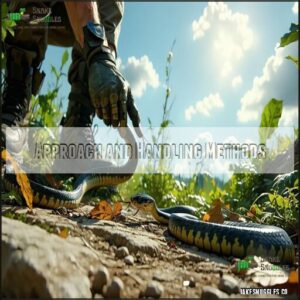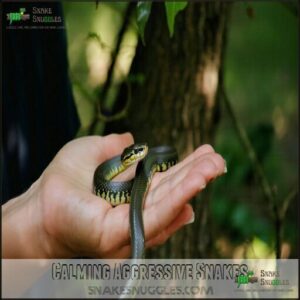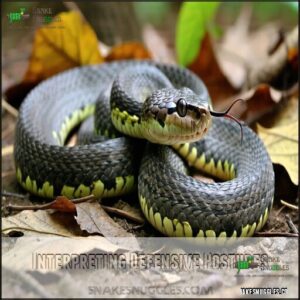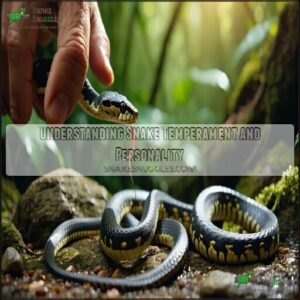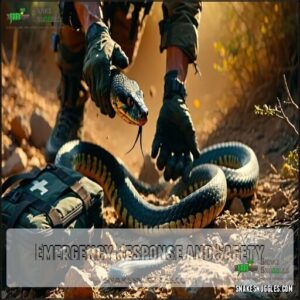This site is supported by our readers. We may earn a commission, at no cost to you, if you purchase through links.
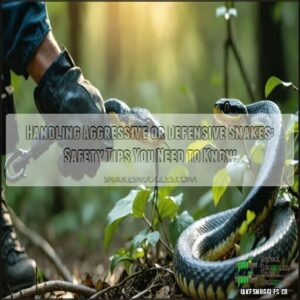 Handling an aggressive or defensive snake takes patience and caution. Most snakes act out of fear, not aggression, so stay calm and avoid sudden movements—think of it as tiptoeing around a stressed friend.
Handling an aggressive or defensive snake takes patience and caution. Most snakes act out of fear, not aggression, so stay calm and avoid sudden movements—think of it as tiptoeing around a stressed friend.
Watch for warning signs like hissing, coiling, or striking distance. Use tools like hooks or tongs to maintain control and protect yourself.
Always handle from behind the head if necessary, but only with proper training. Provide a quiet, stress-free environment to help the snake relax.
Remember, prevention is key. Understanding body language and triggers can make handling safer and smoother. Curious about calming techniques? Stay tuned!
Table Of Contents
Key Takeaways
- Recognize stress signals like hissing, coiling, or puffing, and respond calmly to avoid escalating the snake’s defensive behavior.
- Use tools like snake hooks, tongs, and protective gear to maintain safety during handling and reduce risks for both you and the snake.
- Handle snakes gently and create a quiet environment to minimize anxiety and aggressive reactions.
- Understand the snake’s body language, triggers, and temperament to anticipate its behavior and ensure safe interactions.
Recognizing Defensive Behavior
When handling snakes, it’s important to understand the difference between defensive and aggressive behavior to stay safe.
Recognizing signs like hissing, coiling, or striking can help you respond calmly and avoid escalating the situation, which is crucial for maintaining safety and avoid unnecessary risks.
Recognize hissing and coiling as signs of stress—respond calmly to ensure safety and reduce unnecessary risks during handling.
Aggressive Posturing Signs
Defensive posturing, like coiling or raising the head, signals a snake’s discomfort.
Flattening the neck or assuming an "S" shape often precedes a strike during defensive snake behavior. Recognizing these aggressive posturing signs helps you respond calmly.
These stress signals are part of a snake’s defense mechanisms to avoid confrontation.
Understand these behaviors to guarantee safe and effective handling.
Warning Signals and Threat Displays
Snakes communicate discomfort through various threat displays.
Watch for these warning signs:
- Defensive posturing: Coiling tightly or raising the head signals readiness to strike.
- Hissing: Indicates stress or fear.
- Rapid tongue flicking: Suggests heightened alertness.
- Puffing up: Makes the snake appear larger as a defense mechanism.
Recognizing these behaviors helps avoid triggering aggressive snake handling situations.
Understanding their snake sense danger is essential for safe interactions.
Stress Factors and Triggers
Recognizing defensive behavior starts with understanding what sets a snake off.
Stress factors like loud noises or quick movements can heighten snake anxiety.
Environmental stress, such as overcrowded enclosures, adds to snake frustration.
Mishandling or sudden gestures may trigger aggression.
A human threat—real or perceived—amplifies defensive behavior.
Careful snake behavior analysis helps you predict and avoid aggression triggers during handling.
Safe Handling Techniques
Handling an aggressive or defensive snake requires the right tools and a calm approach to stay safe.
Learning techniques like using snake hooks or tongs and wearing protective gear helps you manage the situation effectively.
Using Snake Hooks and Tongs
If you spot defensive behavior, snake hooks and tongs give you safe control.
Choose sturdy hook materials for better grip and balance. For tongs handling, use light pressure to avoid harm during snake restraint.
Practice tong techniques to safely reposition an aggressive snake. These snake handling techniques reduce stress for both you and the reptile, keeping everyone secure.
Understanding proper snake hook equipment is essential for effective snake handling.
Protective Gear and Equipment
The right protective gear is a must for safe snake handling.
It shields you from bites and guarantees control.
Always gear up with:
- Biteproof gloves for hand protection.
- Safety glasses or face shields to guard your eyes.
- Protective boots to keep legs safe.
- Reliable snake hooks for distancing and control.
- Clean, well-maintained snake handling gloves for comfort and safety.
When handling aggressive snakes, wearing bite proof gear is essential for preventing injuries.
Approach and Handling Methods
Start with a calm approach—move slowly and avoid quick gestures around an aggressive snake. A gentle touch paired with snake hooks guarantees safety and control.
Always follow safety protocols while employing proper snake handling techniques. For handling aggressive snakes, look at this quick guide:
| Handling Step | Tool Needed | Purpose |
|---|---|---|
| Slow Approach | None | Reduces stress |
| Gentle Touch | Gloves | Prevents accidental bites |
| Snake Control | Snake Hooks | Maintains safe distance |
This guide emphasizes the importance of a slow approach and gentle touch to ensure safe handling of aggressive snakes.
Calming Aggressive Snakes
When a snake acts aggressively, it’s often reacting to fear or stress.
Aggressive snake behavior usually stems from fear or stress, not malice—patience and calm handling can ease the tension.
Creating a quiet environment and using slow, steady handling techniques can help reduce anxiety and calm the animal.
Creating a Quiet Environment
When handling aggressive snakes, a calm environment makes a difference.
Quiet spaces with minimal noise and reduced lighting help the snake feel secure. Use a calm approach and introduce calming sounds, like soft rustling.
A gentle touch reassures them without pressure. By keeping a quiet environment, you’ll notice defensive behavior fading as the snake becomes less threatened, resulting in a more secure interaction.
Reducing Stress and Anxiety
Reducing stress and anxiety in handling aggressive snakes starts with understanding their needs.
Environmental enrichment, like adding hiding spots, minimizes defensive behavior.
Recognize stress signals such as hissing or tongue flicking, as they guide your calm approach.
Use gentle handling, avoiding sudden movements.
Snake calming becomes easier with consistent routines and anxiety minimization, building trust and reducing overall stress.
Handling and Support Techniques
When handling aggressive snakes, use gentle restraint to minimize defensive behavior.
Snake lifting should involve proper support methods, ensuring the midsection is well-supported.
Always rely on handling tools, like snake hooks, for added control and safety.
Follow strict safety protocols and maintain a calm approach.
Applying proven snake handling techniques guarantees better interaction and builds trust while using snake restraint tools effectively.
Understanding snake safety protocols is vital for successful snake handling and interaction, and following these guidelines ensures a safe approach.
Snake Behavior and Body Language
Understanding a snake’s behavior and body language helps you handle it safely and confidently.
By watching for defensive postures and stress signals, you can recognize when a snake feels threatened or uneasy.
Interpreting Defensive Postures
Learning defensive postures helps you spot an aggressive snake before it strikes.
Watch for these signs in snake body language:
- Coiling: A classic threat display often paired with a raised head.
- Flattened body: Signals defensive behavior and stress.
- Hissing or puffing: A clear "back off" warning.
- Sudden movements: Immediate Snake Alerts of agitation.
Stay observant to avoid triggering aggression! Understanding snake body language is essential for safe handling.
Recognizing Stress Signals and Warning Signs
Recognizing stress signals and warning signs is key to safe handling.
Defensive postures, like coiling or hissing, often indicate discomfort.
Rapid tongue flicking or puffing signals a stressed snake.
Watch for aggression triggers such as sudden movements or loud noises.
Always respect snake behavior to avoid escalating tension.
| Stress Signal | What It Means | Defensive Posture | Response |
|---|---|---|---|
| Coiling tightly | Preparing to defend | Defensive stance | Move slowly, back off |
| Rapid tongue flicking | High alert or stress | None | Stay calm, limit movement |
| Puffing up | Feeling threatened | Coiled or tense | Approach with caution |
| Hissing sound | Warning or discomfort | Open-mouthed stare | Avoid sudden movements |
When interacting with snakes, it’s crucial to understand and respond to their defensive postures and warning signs appropriately to ensure a safe experience for both humans and animals.
Understanding Snake Temperament and Personality
Every snake has its unique temperament and personality traits.
Species characteristics play a big role in their behavioral patterns.
While a defensive snake may exhibit stress signals like hissing or coiling, an aggressive snake might display stronger reactions.
Understanding snake psychology helps you anticipate their behavior, ensuring safer interactions.
Recognizing a snake’s temperament avoids mistakes, keeping you and the snake calm and secure.
Ensuring safer interactions is crucial when dealing with snakes, and this can be achieved by understanding their behavior and temperament.
Managing Cage Aggression
Managing cage aggression starts with understanding your snake’s environment and habits. By adjusting housing conditions and feeding practices, you can reduce stress and make interactions safer.
Environmental Factors and Housing
Creating the ideal habitat means prioritizing enclosure design with proper temperature control, humidity levels, and substrate choice.
A spacious snake enclosure with hiding spots reduces stress and aggression. Environmental enrichment, like climbing branches or varied textures, boosts comfort.
For creating suitable habitats, consider researching appropriate snake enclosures.
Lighting options should mimic natural cycles, helping maintain calm behavior. Snake habitat modification fosters security, which minimizes defensive reactions effectively.
Feeding Habits and Techniques
Aggressive snakes can be triggered by their feeding environments.
Feeding outside their enclosure helps prevent defensive snakes from associating you with food. Stick to regular feeding times and offer prey sized appropriately for their snake diet and nutrient requirements.
Use tools to present food safely, avoiding your hands. Proper snake feeding minimizes stress and supports healthy feeding responses, improving overall snake behavior with regular feeding times.
Reducing Aggression and Stress
To reduce snake aggression, focus on stress reduction and snake calming techniques.
A calm demeanor during gentle handling helps ease defensive snakes.
Provide environmental enrichment, like hiding spots, to lessen stress signals.
Always approach slowly, respecting their space.
Controlling aggression starts with minimizing triggers, like sudden movements or loud noises.
Over time, these strategies encourage trust and control snake aggression effectively.
Emergency Response and Safety
If a snake bite happens, staying calm and taking quick action can make all the difference.
Knowing proper first aid and having the right tools ready guarantees you handle emergencies safely and effectively.
Dealing With Snake Bites and Injuries
Snake bites can happen, even with precautions. Stay calm and act quickly.
- Clean the wound with antiseptic to reduce infection.
- Apply pressure if bleeding and monitor for snake bite symptoms like swelling or pain.
- For venomous bites, seek antivenom treatment immediately.
Bite prevention, proper injury response, and following emergency response procedures can save lives and minimize risks effectively.
First Aid and Medical Response
If a snake bite happens, start with wound cleaning to prevent infection.
Recognize snake bite symptoms quickly, like swelling or pain, and identify the species for antivenom treatment.
Keep medical kits handy with essentials like bandages and antiseptic.
Follow emergency response procedures, staying calm.
Snake bite treatment depends on timely first aid and medical support.
Preventing Accidents and Ensuring Safety
After addressing snake bites effectively, focus on safety protocols to prevent mishaps.
Stick to snake safety protocols by wearing protective gear, pre-checking tools, and ensuring a clutter-free space.
Accident prevention hinges on recognizing defensive behavior early, while proper risk management means never skipping precautions.
Emergency planning—like keeping first aid nearby—ensures you’re ready for hazards.
Prioritize hazard control to avoid snake attack responses altogether.
Understanding snake handling safety techniques, such as proper handling methods, is essential for minimizing risks when interacting with snakes.
Conclusion
It’s ironic how handling an aggressive or defensive snake often starts with controlling your own nerves.
By recognizing warning signs and using safe techniques, you can defuse tension and avoid unnecessary risks.
Tools like hooks, calm movement, and reducing stress factors create a safer environment for both you and the snake.
Prevention, patience, and understanding their behavior are your best allies.
With these steps, you’re ready to handle even the most defensive snake with care and confidence.
- https://journals.ku.edu/reptilesandamphibians/article/view/16079/14405
- https://www.ncbi.nlm.nih.gov/pmc/articles/PMC5865084/
- https://goodcompanionsvets.co.uk/wp-content/plugins/vetstream_swagger/pet-health/pet/pet_info_print.php?vetstream-type=ZXhvdGlzL3JlcHRpbGVz&nodeguid=a707b301-ade1-4c4d-b197-abce2d2ebc62



